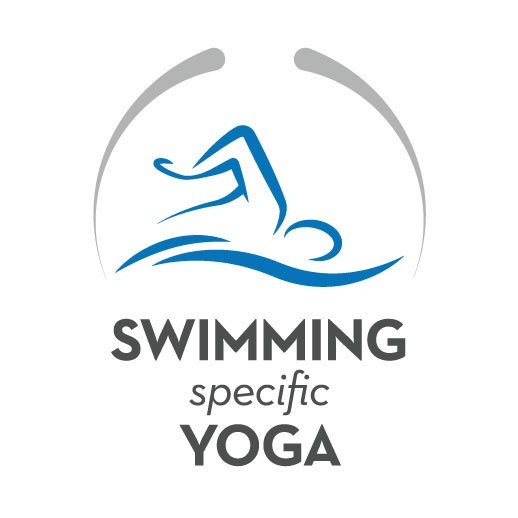To adapt to the stresses of training proper recovery is essential. One way to help enhance that process is through a yoga practice designed for swimming.
Four of the ways a swimming-specific yoga practice can help optimize your recovery are:
- Activating the parasympathetic nervous system
- Reducing stress
- Releasing muscle tension
- Improving Sleep
Activating the Parasympathetic Nervous System
The parasympathetic nervous system is responsible for recovery and regeneration. By activating this part of your nervous system you experience a relaxation response, which includes:
- Activation of neural structures involved in attention
- Decreased metabolism
- Lowered heart rate
- Reduced respiratory rate
- Increased brain plasticity
Yoga helps create this relaxation response (Lazar et al. 2000; Melville et al. 2012). One of the ways this is accomplished is through the connection to the breath.
A breathing technique (pranayama) is the three-part breath. To perform this breath:
- Allow the air flow through the nose
- On each inhale feel your abdomen expand, ribs widen and chest rise
- On each exhale feel that same pattern in reverse allowing the air to slowly leave the body
- Progressively deepen the inhale and extend the exhale
- To increase your ability to relax with greater ease make the length of your exhale longer than your inhale
This process slows the speed of the breath, which activates the relaxation response (Van Diest et al. 2014).
Stress Reduction
Several mindful practices including yoga have been shown to reduce stress and assist in recovery (Sharma et al. 2009). Professional sports teams such as the Golden State Warriors and Seattle Seahawks use yoga and mindful practices as part of their training programs.
There is a lot of confusion around the word mindfulness. John Kabot-Zinn the creator of MBSR (mindfulness based stress reduction) defines it as:
“The awareness that arises through paying attention on purpose in the present moment non-judgmentally.”
It is not unusual for people to find a mindfulness practice frustrating. One reason is that many have the misconception that the goal is to stop thinking.
The intent of mindfulness is to bring your awareness to the thoughts or feelings you are having without allowing them to steal your attention away from the present moment (which they will). When you notice that your thoughts have grabbed your attention simple return back to your point of focus (as described below).
It is truly a practice of returning.
Dan Harris, the author of 10% Happier, explains the practice using the metaphor of a waterfall:
“Picture the mind like a waterfall, they said: the water is the torrent of thoughts and emotions; mindfulness is the space behind the waterfall. Again, elegant theory – but, easier said than done.”
Two ways you can practice mindfulness during a swimming-specific yoga session include:
- Breath awareness
- Body awareness
Strengthening your present moment awareness can be done by using the breath and/or the body as an anchor or home base for your attention. This practice can be done both when moving and in stillness.
Moving Meditation Sequence
Doing an easier yoga sequence where you focus on following your breath is a great way to do a moving meditation focused on recovery.

Exhale

Inhale
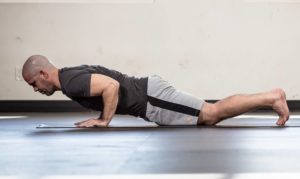
Exhale

Inhale

Exhale
As you move through the sequence use your breath or the responses in your body as a home base for your attention.
Restorative Poses
Legs Up the Wall is a gentle inversion that helps activate the parasympathetic nervous. Coming into this pose for an extended period of time allows your body to relax in a supported position giving you an opportunity to focus on your breath or move through a body scan.
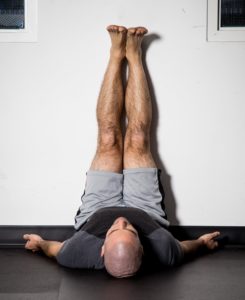
Reducing Muscle Tension
Yoga is a great to way to help release muscle tension. Combining restorative yoga poses with body scanning helps develop greater body awareness by increasing that awareness you can identify where you are holding tension. Once you have where you have tightness work with your breath to intentionally relax those areas.
Swimmers hold a lot of tension in the thoracic spine as well as the chest and shoulders. Restorative Fish pose is a perfect pose to allow for tension in those areas to release.
Yoga for Swimmers Pose – Restorative Fish
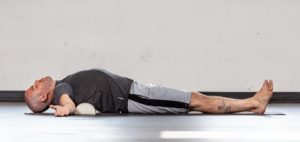
- Place a bolster or half foam roller across your mat
- Lie down on your back with the bolster or half foam roller under your shoulder blades
- Place your arms above the bolster or half foam roller so that they can rest on the ground with the palms facing the sky
- Either place your head on the floor or onto a block ensuring the neck is comfortable and not strained
- Make sure that you can relax into the pose to allow yourself the opportunity release tension
- Come into the pose for 20-50 three part breaths
Yoga Nidra for Swimmers
Another method to help relieve muscle tension is yoga nidra.
Yoga Nidra is known as yogic sleep. In essence it is a form of guided meditation that engages the parasympathetic nervous system through heightened body awareness and attention to the breath.
“Yoga Nidra provides a way of contacting and resting within Pure Awareness as it exists beneath the waking and dreaming/imagery states of mind.
It involves guided practices that gently draw one’s attention inward, through various aspects of body, breath and being. This progressive inner attention invites the activity of the mind to gradually still along the way, while going ever deeper toward conscious deep sleep.” – Jennifer Piercy
The following is a short 18 minute Yoga Nidra session.
For this practice find a position where you are at ease, that will be restful for the length of the class. Many choose to practice in a classic savasana pose, but feel free to choose a different position that will allow you to relax.
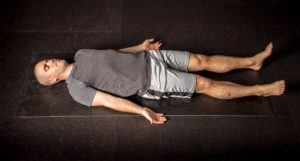
Improving Sleep
Sleep is an essential element in enabling you to recover effectively from training. Getting a good night’s sleep will positively effect:
- Stress regulation
- Muscle recovery
- Metabolic function
- Motor control
For many a quality night’s sleep is elusive.
Mindful practices have been shown to both help induce and increase the quality of sleep. In a 2018 study athletes who did a brief 6-minute self-administered session of mindfulness experienced a decrease in pre-sleep arousal and improvement in their quality of sleep (Li et al. 2018).
Incorporating any of the practices in this article into a pre-sleep routine can help give the brain a signal to begin to transition from a waking state to a sleeping state.
…
Lazar, S.W., Bush, G., Gollub, R.L., Fricchione, G.L, Khalsa, G., Benson, H. 2000. Functional brain mapping of the relaxation response in meditation. 11(7): 1581-1585
Li, Chunxiao & Kee, Ying Hwa & Shan Lam, Lok. (2018). Effect of Brief Mindfulness Induction on University Athletes’ Sleep Quality Following Night Training. Frontiers in Psychology. 9. 508. 10.3389/fpsyg.2018.00508.
Melville, G.W., Chang, D., Colagiuri, B., Marshall, P.W., Cheema, B.S. 2012. Fifteen minutes of chair-based yog postures or guided meditation performed in the office can elicit a relaxation response. Ev-BasedCompl & Alt Med. DOI: 10.115/2012/501986
SHARMA, PRITHA; Sharma, Pritha., Kendrick, Kevin; and Chilek, Daniel R. Jr (2009) “Effect of Hatha Yoga on Stress and Recovery of Female Collegiate Athletes,” International Journal of Exercise Science: Conference Proceedings: Vol. 2 : Iss. 1 , Article 30.
Van Diest, I., Verstappen, K., Auber, A.E., Widjaja, D., Vansteenwegen, D., Vlemincx, E. 2014. Inhalation/exhalationratio modulates effect of slow breathing on heart rate variability and relaxation. App Psychophys Biofeed. DOI: 10.1007/s10484-014-9253-x
…
This Yoga for Swimmers article is brought to you by Swimming-Specific Yoga the world’s top resource for online yoga classes and content designed for swimmers and multi-sport athletes.
…
Sign up here to receive the Swimming Specific Yoga newsletter
The newsletter includes information on how yoga can enhance both your swimming performance and your wellness.
…
What people are saying about Swimming-Specific Yoga
…
Visit our website swimminspecificyoga.com to take a 7 day free trial of the Swimming-Specific Yoga Online Studio membership.
With your membership you gain access to over 100 classes ranging from 15-60 minutes that have been created for the specific needs of swimmers.
